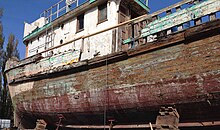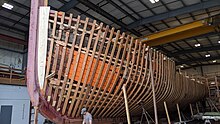The Western Flyer is a fishing boat, most known for its use by John Steinbeck and Ed Ricketts in their 1940 expedition to the Gulf of California, the notes from which culminated in their 1941 book Sea of Cortez, later reworked by Steinbeck into The Log from the Sea of Cortez (1951). According to Kevin Bailey, "the most famous fishing vessel ever to have sailed", the 77-foot (23 m) Western Flyer was restored in Port Townsend, Washington. The Western Flyer Foundation was formed with the goal of educating youth about the intersection of science and literature.

Construction
The Western Flyer was built in Tacoma, Washington, in 1937 by the Western Boat Building Company, owned by Martin Petrich. Petrich partnered with brothers Tony and Frank Berry to build the seiner, which is made from old-growth fir. It was designed specifically for the Monterey, California sardine fishery, with the capability of heading to Alaska annually for salmon. On July 3, 1937, the Flyer was completed.
Steinbeck and the Sea of Cortez
Steinbeck and Ricketts chartered the Western Flyer in 1940 for a voyage to the Sea of Cortez. The Flyer was captained by Anton "Tony" Berry, with crew members Tex Travis, Horace "Sparky" Enea, and "Tiny" Colletto. Steinbeck's wife, Carol, was also on board for the excursion. They embarked on March 11, 1940, from Monterey. Along the coast, Steinbeck and Ricketts collected specimens, logging their observations, many of which were included in "The Log". The journey ended on April 16, 1940, in San Diego, California, after a journey of 4,000 miles (6,400 km).
After Steinbeck
Following Steinbeck's voyage, the ship was returned to its main purpose: fishing. Over the ensuing years it was used to harvest sardines, perch, and crab, angling from California to Alaska's Aleutian Islands.

In 1983 Bob Enea, the nephew of Tony Berry, began a search for the Western Flyer which had been renamed Gemini. Enea discovered the boat in Anacortes, Washington in 1986 where it was still operating as a commercial fishing vessel. His attempts to purchase the boat from owner Ole Knudson were rebuffed until 1993 when Knudson decided to retire from fishing and offered to sell the ship to Enea for $100,000. Enea established the non-profit Western Flyer Project to raise money to purchase the vessel. The publicity generated by the announcement of the Western Flyer's discovery attracted the attention of real estate developer Gerry Kehoe who immediately purchased the boat from Knudson over Enea's objections, announcing plans to move it to Salinas where it would be placed in drydock as the centerpiece of a new theme restaurant.
Twice in 2012 the boat sprang leaks and sank, being refloated each time. After the second sinking, Kehoe transported the boat from Anacortes to Port Townsend, Washington to undergo refurbishment in preparation for relocation to Salinas.
Restoration
In early 2015 the boat was sold to John Gregg for a reported $1,000,000. Gregg enlisted Port Townsend Shipwrights Co-Op to restore the vessel to its historic glory, while exceeding modern safety, technological, and environmental standards. The vessel includes a custom Remotely operated underwater vehicle, designed by Gregg, that resembles a nautilus. In 2016, The Western Flyer Foundation was established to support Western Flyer's focus on public education and science; students will participate in the collection of real data, implementing a citizen science approach.

On June 29, 2022, Western Flyer was relaunched after its restoration at Port Townsend was completed, and towed to Seattle to receive a new hybrid engine and further outfit, before returning to Monterey. The engine installation and the conversion of the fish hold to a science lab and teaching space were completed by Snow and Company, Seattle, in mid-2023 and on November 4 Western Flyer arrived at Monterey to complete outfitting.
References
- Hutchison, Patrick (March 18, 2015). "A New Life for the Boat Immortalized by John Steinbeck". Seattle Weekly. Archived from the original on September 24, 2015. Retrieved August 30, 2015.
- ^ Bailey, Kevin (2015). The Western Flyer: Steinbeck's Boat, the Sea of Cortez, and the Saga of Pacific Fisheries. University of Chicago Press. pp. 8–9. ISBN 022611676X.
- "H.C. HANSON COLLECTION". www.whatcommuseum.org. Retrieved November 5, 2023.
- "A marine tragedy: Steinbeck boat follows collapse of West Coast fisheries". Alaska Dispatch News. Retrieved February 23, 2016.
- Gillie, John (August 28, 2013). "Groups fight over famous fishing boat's future". Bend Bulletin. Archived from the original on December 24, 2016. Retrieved August 30, 2015.
- Curwen, Thomas; van der Brug, Brian (November 3, 2023). "A $7-million dream: Steinbeck's vintage sardine boat makes its modern debut". Los Angeles Times. Retrieved November 5, 2023.
- "Dan Haifley, Our Ocean Backyard: 'Western Flyer's' journey continues". Santa Cruz Sentinel. Archived from the original on October 27, 2021. Retrieved February 23, 2016.
- Kelly, Brian (July 8, 2022). "Port Townsend bids farewell to Western Flyer". The Leader. Port Townsend, WA. Archived from the original on July 9, 2022. Retrieved August 27, 2022.
- Hein, Jan (March 15, 2024). "Western Flyer Restoration: The John Steinbeck fishing seiner". Classic Boat. London. Archived from the original on May 12, 2024. Retrieved May 12, 2024.
External links
- Western Flyer Foundation home page
- "John Steinbeck's "Western Flyer" gets brought back to life". CBS Saturday Morning. December 23, 2023. Retrieved May 12, 2024.